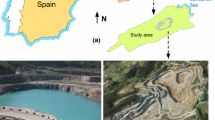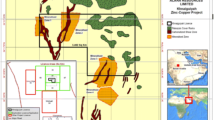Abstract
The efficient use of water resources in arid region has become highly relevant in the evaluation and mining planning, since the exploration phase to closure. The objective of the numerical groundwater model was to assess the potential for groundwater extraction to meet mine water demand from one of the driest area in the world. Numerical groundwater models were used to assess groundwater resource. Modelling was undertaken using MODFLOW-SURFACT code, an advanced MODFLOW based code, within the framework of Visual MODFLOW version 4.6. A steady state model was developed to assess the regional groundwater flow pattern and to calibrate the recharge and hydraulic conductivity parameters in the model. The model was calibrated with a correlation of coefficient of 0.997, and root-mean-squared error is 0.3 m. A transient simulation model was used to predict the impact of 1.5 million cubic metre/year extraction for 10 years on the main aquifer hydrogeological regime, including after cession of pumping. Modelling simulated four hydrogeological scenarios. Model results for the ‘worst case’ scenario suggested that the Saq Sandstone aquifer should be capable of supplying the mine water demand (1.5 million cubic metre (MCM)/year) for 10 years. However, the long-term water-level drawdown shows a continuous decrease without achieving steady state conditions; thus, the majority of water is being taken from aquifer storage, and in the long term, there will be a mutual interference from a borefield located to the north of the model area. In this area, the hydraulic gradient is relatively steep and over-pumped for more than 28 years. Other scenario shows that there will be a recovery of around 8 m out of the 11.6-m drawdown, after 18 years of cession of pumping, implying that the aquifer will be stressed and a large percentage of water taken from aquifer storage. To minimise hydrogeological impacts, it is recommended to laterally spread out production bores, bores should be located where the Saq Sandstone is deepest, and operate the bores at low extraction rates. Overall, this study presents a useful numerical model output for mine water supply assessment and will contribute towards improving water resources management under different conditions in one of the world driest area.

















Similar content being viewed by others
References
Abunayyan (Trading Corporation) and BRGM (Bureau de Recherches Géologiques et Minières) (2008). Investigations for updating the groundwater mathematical model(s) of the Saq overlying aquifers (main report) and (geology). Published by the Ministry of Water and Electricity in Saudi Arabia. Available at: http://www.scribd. com/doc/16845648/Saq-Aquifer-Saudi-Arabia-2008; http://www.scribd.com/doc/16769693/FR-Vol-13-Geology. Accessed on May 12, 2016.
Al-Salamah, I. S., Ghazaw, Y. M., & Ghumman, A. R. (2010). Groundwater modeling of Saq aquifer Buraydah Al Qassim for better water management strategies. Environmental Monitoring and Assessment, 173(1–4), 851–860.
Barnett, B., Townley, L. R., Post, V., Evans, R. E., Hunt, R. J., Peeters, L., Richardson, S., Werner, A. D., Knapton, A., & Boronkay, A. (2012). Australian groundwater modelling guidelines. National Water Commission, Canberra: Waterlines report.
Doherty, J. (1994). PEST—model independent parameter estimation (122 p). Corinda, Australia: Watermark Computing.
Fetter, C. W. (2001). Applied hydrogeology (4th ed.). Englewood Cliffs, NJ: Prentice Hall.
Freeze, R. A., & Cherry, J. A. (1979). Groundwater. Englewood Cliffs, NJ: Prentice Hall.
Gingerich, S. B. (2008). Ground-water availability in the Wailuku area, Maui. Hawai’i. US Geology Surveys Science Investigations Report, 2008–5236.
Hagedorn, B., El-Kadi, A. I., Mair, A., Whittier, R. B., & Ha, K. (2011). Estimating recharge in fractured aquifers of a temperate humid to semiarid volcanic island (Jeju, Korea) from water table fluctuations, and Cl, CFC-12 and 3H chemistry. Journal of Hydrology, 409(3–4), 650–662.
Harbaugh, A. W., Banta, E. R., Hill, M. C., McDonald, M. G. (2000). MODFLOW-2000, the U.S. Geological Survey modular ground-water model: user guide to modularization concepts and the ground-water flow process. US Geol Surv Open-File.
HGL (2013). HydroGeoLogic, Inc. MODFLOW-SURFACT . Version 4.0. User's manua; and guide. VA, USA. https://www.hgl.com/expertise/modeling-and-optimization/software-tools/modflow-surfact.
Mair, A., Hagedorn, B., Tillery, S., El-Kadi, A. I., Westenbroek, S., Ha, K., & Koh, G.-W. (2013). Temporal and spatial variability of groundwater recharge on Jeju Island, Korea. Journal of Hydrology, 501, 213–226.
Middlemis, H. (2004) Benchmarking best practice for groundwater flow modelling. The Winston Churchill Memorial Trust of Australia.
Pollock, D. W. (1994). User’s guide for MODPATH/MODPATH-PLOT, version 3: a particle tracking post-processing package for MODFLOW, The U.S. Geological Survey Finite-difference Ground-water Flow Model: U.S. Geological Survey Open-File Report 94–464, 234 p.
Reilly, T. E., & Harbaugh, A. W. (2004) Guidelines for evaluating groundwater flow models. U.S. Geological Survey Scientific Investigations Report 2004–5038, 30 p.
SMEC (2012). Khnaiguiyah Zinc copper project, mine water supply assessment, numerical groundwater model. For: Khnaiguiyah Mining Company.
Sophocleous, M. (2000). From safe yield to sustainable development of water resources: the Kansas experience. Journal of Hydrology, 235, 27–43.
Turner, R. J., Mansour, M. M., Dearden, R. Ó., Dochartaigh, B. É., & Hughes, A. G. (2015). Improved understanding of groundwater flow in complex superficial deposits using three-dimensional geological-framework and groundwater models: an example from Glasgow, Scotland (UK). Hydrogeology Journal, 23, 493–506.
Whittier, R., Rotzoll, K., Dhal, S., El-Kadi, A. I., Ray, C., & Chang, D. (2010). Groundwater source assessment program for the state of Hawaii, USA: methodology example application. Hydrogeology Journal, 18, 711–723.
Won, J. H., Kim, J. W., Koh, G. W., & Lee, J. Y. (2005). Evaluation of hydrogeological characteristics in Jeju Island, Korea. Geosciences Journal, 9(1), 33–46.
Yihdego, Y., & Becht, R. (2013). Simulation of lake–aquifer interaction at Lake Naivasha, Kenya using a three-dimensional flow model with the high conductivity technique and a DEM with bathymetry. Journal of Hydrology, 503, 111–122.
Yihdego, Y., & Webb, J. A. (2015). Use of a conceptual hydrogeological model and a time variant water budget analysis to determine controls on salinity in Lake Burrumbeet in Southeast Australia. Environmental Earth Sciences Journal, 73(4), 1587–1600.
Yihdego, Y., Danis, C., & Paffard, A. (2015). 3-D numerical groundwater flow simulation for geological discontinuities in the Unkheltseg Basin, Mongolia. Environmental Earth Sciences Journal, 73(8), 4119–4133.
Acknowledgments
The authors would like to thank SMEC and Maxwell Hobson, project manager and the staff of Khaiguiyah Mining Company. We would like to extend our appreciation to Saudi Arabia, Ministry of Petroleum and Mineral Resources, Alara Resources of Australia and United Arabian Manajem Company of Saudi Arabia.
Author information
Authors and Affiliations
Corresponding author
Rights and permissions
About this article
Cite this article
Yihdego, Y., Drury, L. Mine water supply assessment and evaluation of the system response to the designed demand in a desert region, central Saudi Arabia. Environ Monit Assess 188, 619 (2016). https://doi.org/10.1007/s10661-016-5540-8
Received:
Accepted:
Published:
DOI: https://doi.org/10.1007/s10661-016-5540-8




